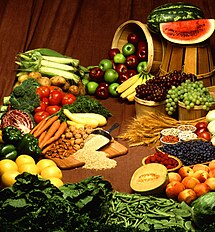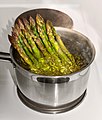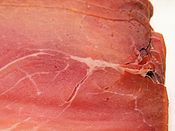Portal:Food
F o o d
A portal dedicated to food and foodways
Introduction


Food is any substance consumed by an organism for nutritional support. Food is usually of plant, animal, or fungal origin and contains essential nutrients such as carbohydrates, fats, proteins, vitamins, or minerals. The substance is ingested by an organism and assimilated by the organism's cells to provide energy, maintain life, or stimulate growth. Different species of animals have different feeding behaviours that satisfy the needs of their metabolisms and have evolved to fill a specific ecological niche within specific geographical contexts.
Omnivorous humans are highly adaptable and have adapted to obtaining food in many different ecosystems. Humans generally use cooking to prepare food for consumption. The majority of the food energy required is supplied by the industrial food industry, which produces food through intensive agriculture and distributes it through complex food processing and food distribution systems. This system of conventional agriculture relies heavily on fossil fuels, which means that the food and agricultural systems are one of the major contributors to climate change, accounting for as much as 37% of total greenhouse gas emissions. (Full article...)
Cooking, also known as cookery or professionally as the culinary arts, is the art, science and craft of using heat to make food more palatable, digestible, nutritious, or safe. Cooking techniques and ingredients vary widely, from grilling food over an open fire, to using electric stoves, to baking in various types of ovens, reflecting local conditions. Cooking is an aspect of all human societies and a cultural universal.
Preparing food with heat or fire is an activity unique to humans. Archeological evidence of cooking fires from at least 300,000 years ago exists, but some estimate that humans started cooking up to 2 million years ago.
The expansion of agriculture, commerce, trade, and transportation between civilizations in different regions offered cooks many new ingredients. New inventions and technologies, such as the invention of pottery for holding and boiling of water, expanded cooking techniques. Some modern cooks apply advanced scientific techniques to food preparation to further enhance the flavor of the dish served. (Full article...)
The Modern Cook was the first cookery book by the Anglo-Italian cook Charles Elmé Francatelli (1805–1876). It was first published in 1846. It was popular for half a century in the Victorian era, running through 29 London editions by 1896. It was also published in America.
The book offered elaborate dishes, described with French terminology such as bisque, entrées, entremets, vol-au-vent, timbale and soufflé. It included bills of fare for meals for up to 300 people, and for a series of eight- or nine-course dinners served to Queen Victoria; one exceptional royal dinner in 1841 had sixteen entrées and sixteen entremets, including truffles in Champagne. (Full article...)
Selected article –

Vegetarianism is the practice of abstaining from the consumption of meat (red meat, poultry, seafood, insects, and the flesh of any other animal). It may also include abstaining from eating all by-products of animal slaughter. A person who practices vegetarianism is known as a vegetarian.
Vegetarianism may be adopted for various reasons. Many people object to eating meat out of respect for sentient animal life. Such ethical motivations have been codified under various religious beliefs as well as animal rights advocacy. Other motivations for vegetarianism are health-related, political, environmental, cultural, aesthetic, economic, taste-related, or relate to other personal preferences. (Full article...)
Selected cuisine -

Mexican cuisine consists of the cooking cuisines and traditions of the modern country of Mexico. Its earliest roots lie in Mesoamerican cuisine. Mexican cuisine ingredients and methods begin with the first agricultural communities such as the Olmec and Maya who domesticated maize, created the standard process of nixtamalization, and established their foodways. Successive waves of other Mesoamerican groups brought with them their cooking methods. These included: the Teotihuacanos, Toltec, Huastec, Zapotec, Mixtec, Otomi, Purépecha, Totonac, Mazatec, Mazahua, and Nahua. With the Mexica formation of the multi-ethnic Triple Alliance (Aztec Empire), culinary foodways became infused (Aztec cuisine).
Today's food staples native to the land include corn (maize), turkey, beans, squash, amaranth, chia, avocados, tomatoes, tomatillos, cacao, vanilla, agave, spirulina, sweet potato, cactus, and chili pepper. Its history over the centuries has resulted in regional cuisines based on local conditions, including Baja Med, Chiapas, Veracruz, Oaxacan, and the American cuisines of New Mexican and Tex-Mex. (Full article...)
Selected ingredient –

Garam masala (Hindustani:- garam masālā, lit. transl. hot or warm spices) is a blend of ground spices originating from the Indian subcontinent. It is common in Indian, Pakistani, Nepalese, Bangladeshi, and Caribbean cuisines. It is used alone or with other seasonings. The specific combination differs by district, but it regularly incorporates a blend of flavours like cardamom, cinnamon, cumin, cloves, bay leaves, star anise, and peppercorns. Garam masala can be found in a wide range of dishes, including marinades, pickles, stews, and curries. (Full article...)
Selected recipe –

Florence Petty (1 December 1870 – 18 November 1948) was a Scottish social worker, cookery writer and broadcaster. During the 1900s, in the socially deprived area of Somers Town, north London, Petty undertook social work for the St Pancras School for Mothers, commonly known as The Mothers' and Babies' Welcome. She ran cookery demonstrations for working-class women to get them in the habit of cooking inexpensive and nutritious food. Much of the instruction was done in the women's homes, to demonstrate how to use their own limited equipment and utensils. Because she taught the women firstly how to make suet puddings—plain, sweet and meat—her students nicknamed her "The Pudding Lady". In addition to her cookery lessons, she became a qualified sanitary inspector.
Petty wrote on cookery, publishing works aimed at those also involved in social work, including a cookery book—The Pudding Lady's Recipe Book, with Practical Hints (1917)—and pamphlet aimed at the public. Both the pamphlet and book contain practical information on how to make and use a haybox as a method of cooking, where heated food is placed in an insulated box to continue to cook, away from a heat source. Petty worked as a lecturer and cookery demonstrator for the National Food Reform Association, travelling round Britain to show cost-efficient and nutritious ways to cook despite the rising food prices and food shortages brought on by the First World War. She was a broadcaster on food and budgeting in the late 1920s and early 1930s, on the 2LO radio station for the BBC, as part of the "Household Talk" series of programmes aimed at housewives. From 1914 until the mid-1940s she toured Britain giving lecture-demonstrations on economical ingredients and cost-effective cooking methods. (Full article...)
Selected image –
Selected biography –
B. 28 October 1846 – d. 12 February 1935
Georges Auguste Escoffier (French: [ʒɔʁʒ oɡyst ɛskɔfje]; 28 October 1846 – 12 February 1935) was a French chef, restaurateur, and culinary writer who popularised and updated traditional French cooking methods. Much of Escoffier's technique was based on that of Marie-Antoine Carême, one of the codifiers of French haute cuisine; Escoffier's achievement was to simplify and modernise Carême's elaborate and ornate style. In particular, he codified the recipes for the five mother sauces. Referred to by the French press as roi des cuisiniers et cuisinier des rois ("king of chefs and chef of kings"—also previously said of Carême), Escoffier was a preeminent figure in London and Paris during the 1890s and the early part of the 20th century.
Alongside the recipes, Escoffier elevated the profession. In a time when kitchens were loud, riotous places where drinking on the job was commonplace, Escoffier demanded cleanliness, discipline, and silence from his staff. In bringing order to the kitchen, he tapped into his own military experience to develop the hierarchical brigade de cuisine system for organising the kitchen staff which is still standard in many restaurants today. He worked in partnership with hotelier César Ritz, rising to prominence together at the Savoy in London serving the elite of society, and later at the Ritz Hotel in Paris and the Carlton in London. (Full article...)
Did you know (auto-generated) –

- ... that by 1967, staff at the Home Office were told not to feed Peta morsels of food as she had become "inordinately fat"?
- ... that food was left to rot outside after the supermarket Supie went out of business?
- ... that the Unitized Group Ration – Express is designed to heat food itself without the need of a field kitchen?
- ... that the reactions to food depicted in the manga series Food Wars!: Shokugeki no Soma were decided on through free association games?
- ... that Jean Webster daily served hundreds of people free food directly out of her home kitchen for over a decade?
- ... that in November 2022, Leicester City Council used the Food Act 1984 in combination with a royal charter of 1199 to levy a charge on the organisers of two Christmas light switching-on events?
More did you know –
Related portals
Food topics
The following are topics relating to food
Categories
Food list articles
- See also: Lists of foods and Category:Lists of drinks
The following are some Food list articles on Wikipedia:

- American cheeses
- Appellation d'Origine Contrôlée cheeses
- Apple cultivars
- Bacon dishes
- Bacon substitutes
- Basil cultivars
- Breads
- Breakfast beverages
- Breakfast cereals
- Breakfast foods
- British cheeses
- Cakes
- Candies
- Cheeses
- Cheese soups
- Christmas dishes (list)
- Cocktails
- Cookies
- Dishes using coconut milk
- Diets
- Doughnut varieties
- Egg dishes
- Fermented soy products
- Food additives
- Food additives (Codex Alimentarius)
- Foods named after people
- French cheeses
- French dishes
- Fried dough foods
- Fruits
- List of hamburgers
- Herbs and spices
- Hors d'oeuvre
- Indian dishes
- Indian snack foods
- Indonesian dishes
- Italian dishes
- Japanese snacks
- Japanese dishes
- Jewish dishes
- Kebabs
- Korean beverages
- Mango cultivars
- Moroccan dishes
- Pasta
- Pastries
- Philippine snack food
- Pies, tarts and flans
- Poppy seed pastries and dishes
- Potato dishes
- Puddings
- Raw fish dishes
- Rice dishes
- Rolled foods
- Sauces
- Seafood
- Seeds
- Sandwiches
- Snack foods
- Soft drinks by country
- Soul foods and dishes
- Soups
- Stews
- Street foods
- Tapas
- Turkish dishes
- Twice-baked foods
- Vegetable oils
- Vegetables
- Vodkas
Things you can do
Related WikiProjects
| Parent project: WikiProject Food and Drink | |
| Child projects: | Task forces: (All inactive) |
|
|
| Related projects: | |
New articles
Rules | Match log | Results page (for watching) | Last updated: 2025-02-20 19:16 (UTC)
Note: The list display can now be customized by each user. See List display personalization for details.
- Lochlea distillery (edit | talk | history | links | watch | logs | tools) by John baost (talk · contribs · new pages (4)) started on 2025-02-20, score: 20
- Gibbs family (bakers) (edit | talk | history | links | watch | logs | tools) by Doug butler (talk · contribs · new pages (25)) started on 2025-02-17, score: 20
- Nightshade (Los Angeles restaurant) (edit | talk | history | links | watch | logs | tools) by Eric Carpenter (talk · contribs · new pages (24)) started on 2025-02-19, score: 10
- Beer in Lebanon (edit | talk | history | links | watch | logs | tools) by Linaduliban (talk · contribs · new pages (1)) started on 2025-02-19, score: 10
- Kim San Leng (edit | talk | history | links | watch | logs | tools) by Jopstories (talk · contribs · new pages (2)) started on 2025-02-16, score: 10
- Lagenophora pumila (edit | talk | history | links | watch | logs | tools) by Richlitt (talk · contribs · new pages (23)) started on 2025-02-14, score: 10
- Coprosma dumosa (edit | talk | history | links | watch | logs | tools) by Richlitt (talk · contribs · new pages (23)) started on 2025-02-12, score: 10
- Local Water Done Well (edit | talk | history | links | watch | logs | tools) by Andykatib (talk · contribs · new pages (15)) started on 2025-02-11, score: 10
- Elf Cafe (restaurant) (edit | talk | history | links | watch | logs | tools) by Eric Carpenter (talk · contribs · new pages (24)) started on 2025-02-18, score: 10
- Toad Sweat (edit | talk | history | links | watch | logs | tools) by TJGuiton (talk · contribs · new pages (2)) started on 2025-02-18, score: 10
- FindSALT (edit | talk | history | links | watch | logs | tools) by Repelroched (talk · contribs · new pages (1)) started on 2025-02-17, score: 10
- Napoli Pizza and Fried Chicken (edit | talk | history | links | watch | logs | tools) by Heeheemalu (talk · contribs · new pages (10)) started on 2025-02-17, score: 20
- P'Zone (edit | talk | history | links | watch | logs | tools) by Howardcorn33 (talk · contribs · new pages (30)) started on 2025-02-16, score: 10
- Waiau Lodge Hotel (edit | talk | history | links | watch | logs | tools) by Panamitsu (talk · contribs · new pages (13)) started on 2025-02-13, score: 10
- Chek ktis (edit | talk | history | links | watch | logs | tools) by Turaids (talk · contribs · new pages (5)) started on 2025-02-15, score: 10
- Vincenzo Buonassisi (edit | talk | history | links | watch | logs | tools) by Horse Eye's Back (talk · contribs · new pages (134)) started on 2025-02-14, score: 10
- Lattanzi Cucina Italiana (edit | talk | history | links | watch | logs | tools) by Eric Carpenter (talk · contribs · new pages (24)) started on 2025-02-14, score: 10
- Neltuma nigra (edit | talk | history | links | watch | logs | tools) by Jts1882 (talk · contribs · new pages (17)) started on 2025-02-13, score: 10
- Pedana kalamkari (edit | talk | history | links | watch | logs | tools) by Hemant Dabral (talk · contribs · new pages (55)) started on 2025-02-13, score: 10
- Murder of Kim Ha-neul (edit | talk | history | links | watch | logs | tools) by NelsonLee20042020 (talk · contribs · new pages (23)) started on 2025-02-12, score: 10
- Walter E. Baethgen (edit | talk | history | links | watch | logs | tools) by Devonian Wombat (talk · contribs · new pages (10)) started on 2025-02-11, score: 10
- Dairy shop (edit | talk | history | links | watch | logs | tools) by Lambiam (talk · contribs · new pages (8)) started on 2025-02-11, score: 20
- Henry IV Seizing the Opportunity to Conclude Peace (edit | talk | history | links | watch | logs | tools) by MaybeItsBecauseImALondoner (talk · contribs · new pages (57)) started on 2025-02-10, score: 10
- Cooking of apples (edit | talk | history | links | watch | logs | tools) by Mrfoogles (talk · contribs · new pages (6)) started on 2025-02-10, score: 20
- Becky Selengut (edit | talk | history | links | watch | logs | tools) by Jill Siggy (talk · contribs · new pages (1)) started on 2025-02-09, score: 10
- Alice Ross (edit | talk | history | links | watch | logs | tools) by CzarJobKhaya (talk · contribs · new pages (1)) started on 2025-02-09, score: 10
- Paniel Meat Processing (edit | talk | history | links | watch | logs | tools) by 24eeWikiUser (talk · contribs · new pages (4)) started on 2025-02-09, score: 10
- Cucumber salad (edit | talk | history | links | watch | logs | tools) by Shirt58 (talk · contribs · new pages (2)) started on 2025-02-09, score: 10
- Ed Cordero (edit | talk | history | links | watch | logs | tools) by YssaLang (talk · contribs · new pages (9)) started on 2025-02-09, score: 10
- Cocoa bean fermentation (edit | talk | history | links | watch | logs | tools) by Rollinginhisgrave (talk · contribs · new pages (5)) started on 2025-02-09, score: 20
- Dek Akeo (edit | talk | history | links | watch | logs | tools) by Emma Oruk (talk · contribs · new pages (5)) started on 2025-02-08, score: 10
- Favour Fawunmi (edit | talk | history | links | watch | logs | tools) by Hildreth gazzard (talk · contribs · new pages (166)) started on 2025-02-08, score: 10
- Culmination Brewing (edit | talk | history | links | watch | logs | tools) by Another Believer (talk · contribs · new pages (101)) started on 2025-02-07, score: 10
- 2025 Chili's Ride the 'Dente 200 (edit | talk | history | links | watch | logs | tools) by Brycenrichter (talk · contribs · new pages (10)) started on 2025-02-05, score: 10
- 2024 Cocoa crisis (edit | talk | history | links | watch | logs | tools) by Rollinginhisgrave (talk · contribs · new pages (5)) started on 2025-01-30, score: 10
Associated Wikimedia
The following Wikimedia Foundation sister projects provide more on this subject:
-
Commons
Free media repository -
Wikibooks
Free textbooks and manuals -
Wikidata
Free knowledge base -
Wikinews
Free-content news -
Wikiquote
Collection of quotations -
Wikisource
Free-content library -
Wikiversity
Free learning tools -
Wiktionary
Dictionary and thesaurus
















































